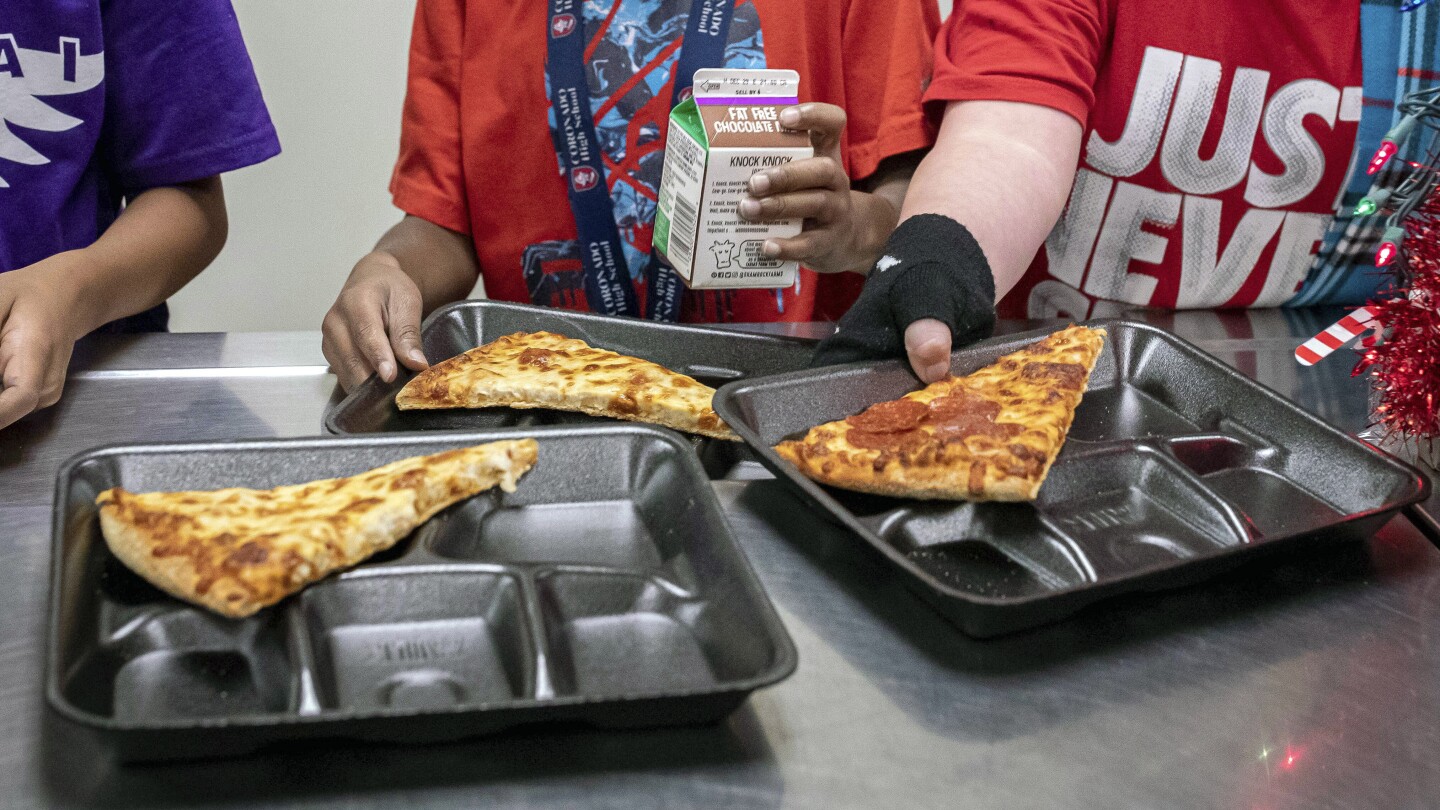Lifestyle
There’s a new push to put whole milk back in school meals. Here’s what you should know

More than a dozen years after higher-fat milk was stripped from school meals to slow obesity in American kids and boost their health, momentum is growing to put it back.
Federal lawmakers have revived bills that would allow whole and 2% milk to be served again in schools, in addition to the skim and low-fat milk mandated since 2012. A U.S. Senate committee hosted a hearing Tuesday on a bill that has bipartisan support.
“Kids need wholesome, nourishing food to grow strong and stay healthy, and whole milk is packed with the nutrients they need,” said Sen. John Fetterman, a Pennsylvania Democrat who is co-sponsoring the legislation.
Health Secretary Robert F. Kennedy Jr. has called the federal dietary guidelines requiring low-fat milk “antiquated” and last month encouraged “full fat/whole milk” to be used in Head Start programs for the nation’s youngest children.
The Obama-era move to require skim and low fat milk in schools was aimed at cutting kids’ consumption of saturated fat and calories, which can increase the risk of heart disease and obesity.
But some nutrition experts, lawmakers and the dairy industry argue that whole milk has been unfairly vilified, and that some studies suggest kids who drink whole milk are less likely to have obesity. Critics also contend that many children don’t like the taste of lower-fat milk and don’t drink it, leading them to miss valuable nutrients.
Here’s what you need to know about the debate over whole milk in school meals:
Why was whole milk removed from school meals?
In 2010, Congress passed the Healthy, Hunger-Free Kids Act, which aimed to reduce childhood obesity and cut health risks for kids. It required school meals to include more whole grains, fruits and vegetables, protein and low-fat dairy and less sugar, sodium and fat.
Starting in 2012, whole and 2% milk was not permitted in school meals because those products are higher in saturated fat and calories than lower-fat options.
Nutrition experts said that skim and low-fat milk gave kids the benefits of necessary nutrients like calcium and Vitamin D with less fat and fewer calories.
How are school meal guidelines set?
The U.S. Agriculture Department sets nutrition guidelines for the national school lunch and breakfast programs, which serve nearly 30 million students each school day.
The nutrition standards are required to meet the federal Dietary Guidelines for Americans, which are reviewed and revised every five years. Since 1985, those guidelines have recommended that Americans older than age 2 consume low-fat or fat-free dairy.
The 2025-2030 dietary guidelines are set for revision this year under a joint effort by USDA and the Department of Health and Human Services. A panel of scientific experts who reviewed evidence regarding milk fat content recommended that the U.S. policy remain the same.
One reason was that research has shown changes in the federal nutrition program after the 2010 law have slowed the rise in obesity among U.S. kids — even teenagers, said Deanna Hoelscher, a nutrition expert and researcher at the University of Texas Health Science Center who served on the dietary guidelines committee.
“We didn’t find enough definitive evidence to change a policy that’s been in place that has shown good outcomes to date,” Hoelscher said.
Although there was limited evidence that consuming higher-fat dairy rather than lower-fat dairy could benefit very young children, there wasn’t enough evidence to make a conclusion for older kids and teens, she said. There were “substantial concerns” with the consistency, quantity and risk of bias in the existing research, the report concluded.
What’s behind
the push for whole milk in schools?
Some nutrition experts point to recent research suggesting that kids who drink whole milk could be less likely to be overweight or develop obesity than children who drink lower-fat milk. One 2020 review of 28 studies suggested that the risk was 40% less for kids who drank whole milk rather than reduced-fat milk, although the study authors noted that the research couldn’t say whether milk consumption was the reason.
One top nutrition expert, Dr. Dariush Mozaffarian of Tufts University, noted that the dietary guidelines panel found “no evidence that whole fat dairy is worse than low-fat dairy,” but they retained the recommendations, citing the need for more research.
“Saturated fat in dairy has not been linked to any adverse health outcomes,” Mozaffarian said.
The pending bills in Congress stipulate that milk fat would not be considered as part of the saturated fat limits required in school meals. That’s because the saturated fatty acids in dairy have a different composition than beef fat, Mozaffarian said, adding that dairy has other beneficial compounds that could offset theoretical harms.
In addition, Mozaffarian noted current USDA guidelines ban whole milk but allow skim and low-fat chocolate and other flavored milk sweetened with added sugars. Last year, the USDA agreed to limit added sugars in school foods for the first time.
Dairy industry advocates say participation in school meals programs and consumption of milk have declined since whole milk was removed.
What’s next?
The USDA and HHS must issue the new dietary guidelines this year. Kennedy and Agriculture Secretary Brooke Rollins have said they are conducting “a line-by-line review” of the scientific report issued under the previous administration — but whether that means a new acceptance of whole milk remains unclear.
Versions of the “Whole Milk for Healthy Kids Act” are pending in both chambers of Congress.
___
The Associated Press Health and Science Department receives support from the Howard Hughes Medical Institute’s Science and Educational Media Group and the Robert Wood Johnson Foundation. The AP is solely responsible for all content.
Lifestyle
In Tunisia, snails inch toward replacing red meat as people turn to cheaper protein

AKOUDA, Tunisia (AP) — In fields outside their hometown in central Tunisia, an increasing number of unemployed young men are seeking a new way to make a living, picking snails off of rocks and leaves and collecting them in large plastic bags to take to the local market to be sold.
More and more people, they say, are buying the shelled wanderers as the price of market staples remains high and out of reach for many families.
“They’re profitable, beneficial and quite in demand,” said Karim, a 29-year-old snail seller from the village of Akouda said.
Snails have been consumed in Tunisia for more than seven millenia, according to research published last year in the journal Archaeological and Anthropological Sciences. In today’s world considered mostly a bistro delicacy, they’re again gaining traction in Tunisia as a practical alternative to red meat — a protein-rich substitute that pairs perfectly with salt, spices, and bold seasonings.
The snails are a lifeline for some in Tunisia, where youth unemployment now hovers above 40% and inflation remains high, three years after spiking to its highest levels in decades. A lack of opportunity has fueled social discontent throughout the country and, increasingly, migration to Europe.
Low in fat and high in iron, calcium and magnesium, snails offer both nutritional value and economic relief. In a country where unemployment runs high and median wages remain low, they cost about half as much as beef per kilogram and often less when sold by the bowl.
“Snails are better for cooking than lamb. If lamb meat costs 60 dinars ($19.30), a bowl of snails is five dinars ($1.60),” a man named Mohammed said at the Akouda market.
As the price of meat and poultry continues to rise, more Tunisians are turning to affordable, alternative sources of protein. Beyond their economic appeal, these substitutes are also drawing interest for their environmental benefits. Scientists say they offer a more sustainable solution, producing far fewer carbon emissions and avoiding the deforestation linked to traditional livestock farming.
Wahiba Dridi, who serves snails at her restaurant in Tunis, cooks them in a traditional fashion with peppers and spices. She said they were popular throughout this year’s Ramadan, which ended last week. Though Tunisian Muslims traditionally eat red meat at the meals during which they break their daily fasts, a kilogram of snails costs less than 28 Tunisian dinars ($9) compared to beef, which costs 55 dinars per kilogram ($18).
“If people knew the value of snails they would eat them all year long,” Dridi said.
Lifestyle
Living abroad and hungry to see a Chinese movie on the biggest of screens, some took action

COLUMBIA, Md. (AP) — A group of Chinese people decided they wanted the nation’s biggest movie to be big in the United States, literally. So they made it really big.
And therein lies a story.
On a recent Saturday afternoon, more than 100 people gathered at an IMAX screening room in a movie theater outside Baltimore. Many were Chinese students and young professionals nearby, parents took their kids, some of whom dressed as the movie’s main characters. Men and women wore Chinese traditional outfits. People lined up to sign their names onto a Chinese scroll and get tickets styled like traditional Chinese paintings. Some posed for pictures with red-tasseled spears and swords.
The screening was organized by volunteers among the Chinese community in the Baltimore-Washington, D.C., area. “Ne Zha 2,” the movie they came to see, is a Chinese film that replaced “Inside Out 2” as the highest-grossing animated film ever at around $2 billion.
You might never have heard of “Ne Zha 2,” though. It is not a big hit internationally. And that’s exactly what the people behind the screening want to change.
An ancient character gets a new treatment
In China, Ne Zha is a well-known traditional fairy character, a child god-general in heaven and also a naughty boy, who was introduced in a story called “Creation of the Gods” written about 400 years ago.
Sun Bohan, a 27-year-old student in Baltimore, wanted to watch the movie on IMAX. The problem? Every IMAX was playing “Captain America: Brave New World,” which premiered on the same day. He asked around and learned the only option would be to rent a theater and pay for the showing at the IMAX. But Sun couldn’t afford that on his own. So he posted on Xiaohongshu, a Chinese social media app; he also started a group on WeChat, China’s most popular messaging platform.
More than 100 people joined his effort and supported it in different capacities.
Raye Xia, a lover of manga, anime and games who had already watched the movie four times, saw Sun’s post and reached out. She spent hours painting a special ticket for the screening that depicted Ne Zha sitting on a dragon under the iconic Washington cherry blossom trees near the Jefferson Memorial.
“It is really rare to see such events in a small town. I love that I’m helping in my own way,” said Xia, who cosplayed as a movie character at the event.
Hoff Xu, a student in Baltimore, stayed up until 3 a.m. the night before and made her own outfit with copper wire, binder clips and old clothes.
“It is not an easy thing for everyone to get together, so I thought I would love to add some effect and vibe to this immersive experience,” Xu said.
Audience members love the cosplay outfits and lined up to take photos with those dressed up.
“As a Chinese, I am really proud to see a Chinese movie as the only one among the top 10 of something,” said Zhao Yuanyuan, who brought her son Jiang Wei’en, 7, to see the movie together for the second time, “I hope he can be exposed to and carry on Chinese traditional culture and not forget his own roots.”
A Chinese grassroots effort on American screens
The communal experience of seeing the movie — and, in particular, the community built by advocating its showing — can help Chinese people in the U.S. make in-person connections in the post-pandemic era. That’s particularly true for a movie some feel isn’t getting its rightful attention globally.
In the U.S., the gatherings reflect the anxiety among the Chinese community under the increasing institutionalized hostility toward immigrants, especially after President Donald Trump returned to office, says Belinda He, an assistant professor of Sinophone cinema and media studies at the University of Maryland.
“The emotional connection could purely outweigh the aesthetic impact and shock that the movie itself brings to them,” He said. “The more severe the institutionalized and structural exclusion here, the more people need to strive for some possibilities through real connections and a sense of belongings.”
Sun wasn’t the only one with the idea. Other Chinese living in the U.S. have organized theater rentals in Indianapolis, Boston and New York City.
Ma Ruoyuan, 31, who works in finance, worked with a friend to organize two screenings that drew a total of 600 people to watch the movie in New York. Ma says participants were highly involved in organizing the events, from seat booking to checking tickets. They even practiced democratic voting in the chat group so people could pick their preferences on the pricing system.
The movie’s rare access to an IMAX screen, Ma believes, is what “brought everyone together.”
IMAX Corp., headquartered in the Toronto area, said the high demand for IMAX screens means it requires studios booking months ahead, if not a year. The company said “Ne Zha 2” was shown on 80 screens for one day on Feb. 12 and expanded to 110 screens after “Captain America” ended.
“IMAX created opportunities to play ‘Ne Zha 2’ across its network in the United States, while honoring its earlier commitments to other releases,” the company said in a written statement.
Within China, “Ne Zha 2” is considered a patriotic movie. Media reports say internet celebrities, private companies and Chinese authorities organized special screenings for their followers and staff.
Earlier this month, all police officers from a court in the east coast province of Shandong were dispatched to watch the movie “to strengthen their belief in the rule of law and draw strength for progress,” the court said on its official Wechat account.
Sichuan, a province in China’s west, helped to fund the movie as part of a program using art projects to alleviate poverty. Media reports say the film’s producers received 15 million yuan ($2.1 million) from the Sichuan provincial government. CMC Pictures, the international production company that produced the movie, refused to comment.
For Sun, who stayed up the night before the screening in Maryland to bake cookies for the audience, the whole experience was an object lesson in collaboration among people who are making their way outside their own society.
“I started as just one person, but people with different skills all came to help,” he said after the screening. “It was worth it.”
Lifestyle
Brown University to see half a billion in federal funding halted by Trump administration

WASHINGTON (AP) — The Trump administration is planning to halt more than half a billion dollars in contracts and grants awarded to Brown University, adding to a list of Ivy League colleges that have had their federal money threatened as a result of their responses to antisemitism, a White House official said Thursday.
Nearly $510 million in federal contracts and grants are on the line, said the official, who was not authorized to speak publicly about the plan and spoke on condition of anonymity.
In an email Thursday to campus leaders, Brown Provost Frank Doyle said the university was aware of “troubling rumors” about government action on its research money. “At this moment, we have no information to substantiate any of these rumors,” Doyle said.
Brown would be the fifth Ivy League college targeted by President Donald Trump’s administration, which is using federal money to enforce its agenda at colleges. Dozens of universities — including every Ivy League school except Penn and Dartmouth — are facing federal investigations into antisemitism following a wave of pro-Palestinian protests last year.
Columbia University was the first one targeted, losing $400 million in federal money with threats to terminate more if it didn’t make the campus safer for Jewish students. The school agreed to several demands from the government last month, including an overhaul of student discipline rules and a review of the school’s Middle East studies department.
The government later suspended about $175 million in federal funding for the University of Pennsylvania over a transgender swimmer who previously competed for the school. On Monday, a federal antisemitism task force said it was reviewing almost $9 billion in federal grants and contracts at Harvard University amid an investigation into campus antisemitism.
And on Tuesday, Princeton University said the administration had halted dozens of its research grants.
The pressure has created a dilemma for U.S. colleges, which rely on federal research funding as a major source of revenue.
Trump’s administration has promised a more aggressive approach against campus antisemitism, accusing former President Joe Biden of letting schools off the hook. It has opened new investigations at colleges and detained and deported several foreign students with ties to pro-Palestinian protests. An incoming assistant professor of medicine at Brown was deported to Lebanon last month for having “openly admitted” to supporting a Hezbollah leader and attending his funeral, the Department of Homeland Security said.
During last school year’s campus protests against the Israel-Hamas war, Brown stood out for a deal it struck with student activists. In exchange for the students’ dismantling an encampment, the university committed to having its governing board vote on whether to divest from companies that protesters said were facilitating Israeli occupation of Palestinian territories.
The Corporation of Brown rejected the divestment proposal.
___
AP Education Writer Collin Binkley contributed. Mumphrey reported from Phoenix.
___
The Associated Press’ education coverage receives financial support from multiple private foundations. AP is solely responsible for all content. Find AP’s standards for working with philanthropies, a list of supporters and funded coverage areas at AP.org.
-

 Africa1 day ago
Africa1 day agoUS president announces global tariffs, including on 51 African nations
-

 Lifestyle2 days ago
Lifestyle2 days agoShingles is awful, but there may be another reason to get vaccinated. It may fight dementia
-

 Sports2 days ago
Sports2 days agoFreddie Freeman misses Los Angeles Dodgers game after injuring ankle in shower ‘mishap’
-

 Europe2 days ago
Europe2 days agoLive updates: Trump announces sweeping new tariffs on imports on ‘Liberation Day’
-

 Asia2 days ago
Asia2 days agoMyanmar’s military government announces temporary ceasefire to aid quake efforts
-

 Middle East2 days ago
Middle East2 days agoIsrael’s Netanyahu heads to Hungary in defiance of ICC arrest warrant | Gaza News
-

 Education2 days ago
Education2 days agoA trans teacher in Texas resigns after being targeted by conservatives online
-

 Sports2 days ago
Sports2 days agoDaria Kasatkina: Russian-born tennis player ‘didn’t have much choice’ over switching allegiances to Australia




